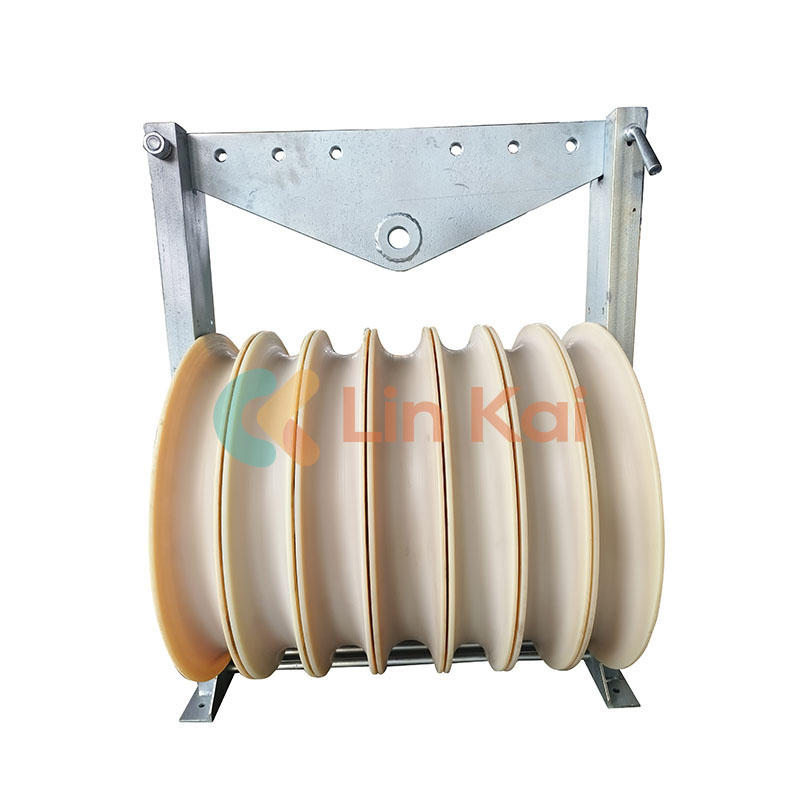Ensuring Longevity: How to Inspect Large Diameter Stringing Blocks for Wear and Tear
2024-05-15
In the realm of power line construction and maintenance, large diameter stringing blocks are indispensable tools that guide conductors with precision. Given their critical role, regular inspection for wear and tear is essential to ensure safety, efficiency, and longevity. Let’s explore the steps and best practices for inspecting large diameter stringing blocks to keep them in optimal condition.
The Importance of Regular Inspection
Large diameter stringing blocks are subjected to significant mechanical stress and environmental conditions during their operation. Regular inspections help identify potential issues early, preventing costly failures and ensuring the safety of the workers and the integrity of the power line installation.
Steps for Inspecting Large Diameter Stringing Blocks
1. Visual Inspection: Start with a thorough visual examination of the stringing blocks. Look for obvious signs of wear and tear, such as cracks, dents, or deformations in the frame, sheaves, and other components. Check for any missing or damaged parts, such as bolts, nuts, and pins. Ensure that all components are securely fastened and in their proper place.
2. Sheave Condition: The sheaves, or wheels, are critical components that guide the conductor. Inspect the sheave surfaces for grooves, nicks, or wear patterns that could indicate excessive friction or contact with the conductor. Ensure the sheaves rotate smoothly without wobbling or binding. Any irregularities in rotation or surface condition can impair the stringing operation and should be addressed promptly.
3. Bearings and Axles: Bearings and axles allow the sheaves to rotate smoothly. Check these components for signs of wear, corrosion, or damage. Listen for unusual noises when rotating the sheaves by hand, which could indicate worn bearings. Lubricate the bearings as needed and replace any that are worn or damaged to maintain smooth operation.
4. Frame and Structural Integrity: The frame supports the entire assembly and must be in good condition. Inspect the frame for cracks, bends, or other structural damage. Pay special attention to welded joints, as these are common points of failure. Any signs of structural compromise should be repaired or the block should be replaced to ensure safety.
5. Safety Mechanisms: Many large diameter stringing blocks are equipped with safety features such as locking mechanisms and guards. Check that these features are functioning correctly. Ensure that locking pins and guards are in place and not damaged. Properly functioning safety mechanisms are crucial for preventing accidents during stringing operations.
6. Corrosion and Rust: Environmental exposure can lead to corrosion and rust, particularly on metal components. Inspect all metal parts for signs of rust or corrosion. Clean any affected areas and apply anti-corrosion treatments or coatings as necessary to protect the equipment and extend its lifespan.
7. Lubrication: Proper lubrication is essential for the smooth operation of moving parts. Check lubrication points and apply the appropriate lubricants as specified by the manufacturer. Over-lubrication or under-lubrication can both lead to issues, so follow the manufacturer’s guidelines closely.
8. Documentation and Records: Keep detailed records of all inspections, including dates, findings, and any maintenance or repairs performed. Regular documentation helps track the condition of the stringing blocks over time and ensures that maintenance schedules are adhered to.
Best Practices for Inspection
- Routine Inspections: Conduct inspections regularly, ideally before and after each major stringing operation. This ensures that any issues are identified and addressed promptly.
- Trained Personnel: Ensure that inspections are carried out by trained personnel who are familiar with the equipment and its operation. Proper training helps identify potential issues that might be overlooked by untrained eyes.
- Manufacturer’s Guidelines: Follow the manufacturer’s guidelines for inspection and maintenance. These guidelines are tailored to the specific design and materials of the stringing blocks and provide valuable information for proper care.
Conclusion
Regular inspection of large diameter stringing blocks is a crucial aspect of maintaining their functionality, safety, and longevity. By following a systematic approach to inspect and maintain these essential tools, power line construction professionals can ensure efficient operations and prevent costly failures. Through diligent inspection and adherence to best practices, large diameter stringing blocks will continue to perform reliably in the demanding environments of power line construction and maintenance.



